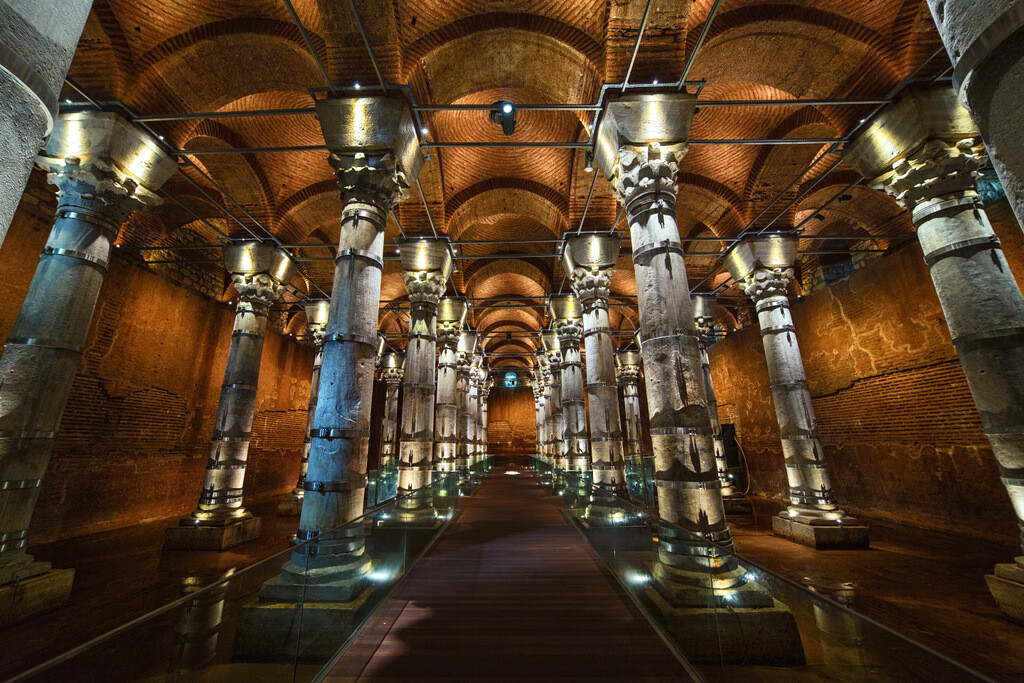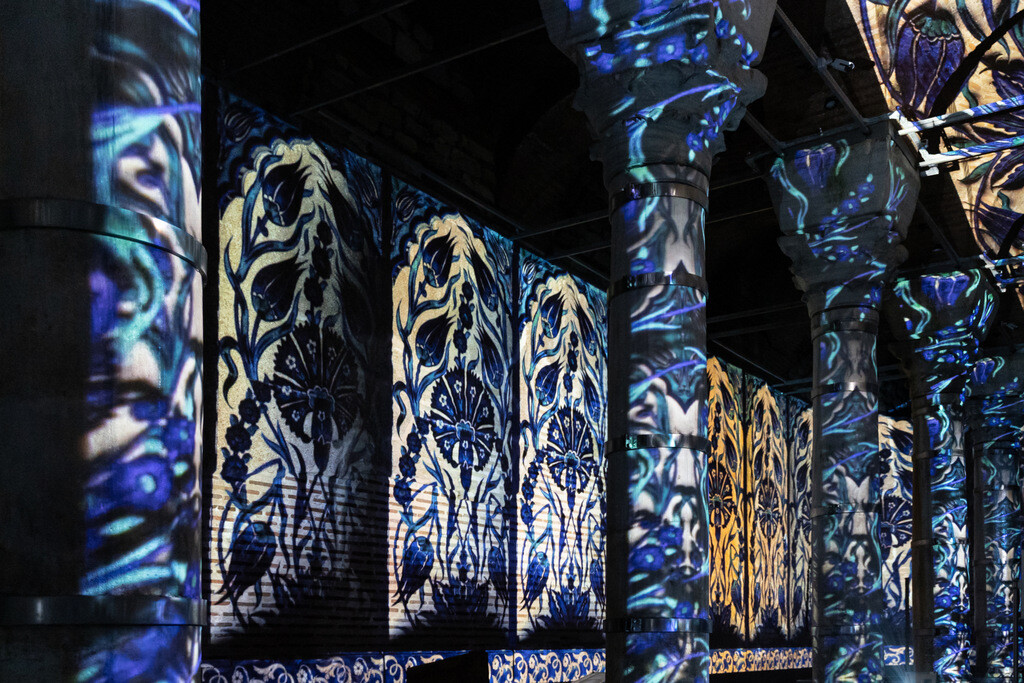Theodosius Cistern is one of the mysterious Byzantine cisterns in Istanbul. The cistern, which was recently restored and opened to visitors, is known locally as the Serefiye Sarnici.
The museum is located in Sultanahmet, Istanbul’s most touristic district. In order to reach the underground cistern, you enter a modern-designed glass room and go down the stairs.
In this article, you can find information about the 1500-year history of Theodosius Cistern. In addition, the Theodosius Cistern entrance fee and opening hours have been noted. In order to tell the history of the cistern properly, we will have to mention the Ancient Greek and Roman periods.
Shortage of Water in Byzantium
Foundation legend of Istanbul dates back to Ancient Greece. Upon departing the city of Megara close by Gulf of Corinth, Byzas and his company came to Seraglio Point (Sarayburnu) and established Byzantium on the hill where Topkapi Palace resides now.
Shortage of water supplies was not a problem for this small community because only a few thousand people resided there at that time. However, after Byzantium was reconstructed and became Constantinople as the second capital of Roman Empire, population explosion caused significant water shortages.
Roman emperors found a solution for this within a few generations. Emperor Valens created the largest water network ever seen and built the Valens Aqueduct, which would bring water to Constantinople through Thrace.
The water shortage in Byzantium seemed to have been solved thanks to the aqueduct built by Valens. But they needed to sustain the flowing water. For that purpose, tens of cisterns were built in the following centuries. Basilica Cistern is no doubt the most famous among them.
Byzantine Cisterns in Istanbul
Until recently, the Basilica Cistern was the only structure that could be visited among the Byzantine Cisterns in Istanbul. Now Theodosius Cistern is among the most valuable museums of Istanbul thanks to eight-year-work of Istanbul Metropolitan Municipality.
If you want to trace thousands of years of Roman-Byzantine history, you can find several more hidden Byzantine cisterns in Istanbul. One of them is the Cistern of Philoxenos, also known as the Binbirdirek Cistern. Binbirdirek is open to visitors only for private events.
The first of the other two is the cistern on Sogukcesme Street, known as Sarnic Restaurant (a 1500-year-old cistern serving as a restaurant) and the last is the Nakilbent Cistern under the Nakkas Carpet Store. There is a magnificent exhibition about the history of chariot races in Constantinople in the cistern on Nakilbent Street.
The History of Theodosius Cistern
The history of the Theodosius Cistern dates back to the 5th century and takes its name from its founder, Emperor Theodosius II. This emperor has an important place in Byzantine history due to his architectural contributions to the city of Constantinople.
To exemplify, Walls of Constantinople (also known as Theodosian Walls) that guarded the city from any kind of threat for ages, was constructed under his reign. Thanks to these walls, Constantinople survived for a thousand years despite the endless attacks of Huns, Persians, Arabs and Bulgarians.
Additionally, we need to keep in mind that it was himself who reconstructed 2nd generation Hagia Sophia. Theodosian Hagia Sophia was demolished during the Nika Revolt which broke out in 532, and Emperor Justinian built the 3rd generation Hagia Sophia that still stands today.
The construction of Theodosius Cistern took nearly 15 years, from 428 to 443. It was crucial for rulers to supply non-stop water in Sultanahmet area because it was the center of the capital in Roman, Byzantine (and even Ottoman) era.
The cisterns we have mentioned in this post were the main cisterns that supply water to the Great Palace, Hippodrome, Hagia Sophia and to several official buildings in Constantinople. For those who want to know more about this, here is a great documentary released by Byzantium 1200.
Theodosius Cistern Entrance Fee 2024
Theodosius Cistern entrance fee is 650 Turkish Lira as of 2024. The ticket price includes the light show you can watch inside. Istanbul Museum Pass is not valid in Theodosius Cistern (aka Serefiye Sarnici). The information on the ticket price was last updated on May 7, 2024.
The Istanbul Museum Pass, a product of the Ministry of Culture and Tourism, is not valid in museums run by the Istanbul Metropolitan Municipality. The other museums in this category are the Basilica Cistern, the Miniaturk Museum, the Panorama 1453 Museum and the Tekfur Palace Museum respectively.
Theodosius Cistern Opening Hours 2024
Theodosius Cistern opening hours are between 09:00 in the morning to 19:00 in the evening. The museum can be visited every day of the week. Information on visiting hours was last updated on May 7, 2024.
Since there is a light show in the cistern, visitors are taken every hour. If you go at a random time, you may have to wait at the door until visitors are admitted during the show time. For example, if you are going to visit the cistern for the light show at 10:00, it is recommended to be there around 9:50. However, if you go at 9:30, you may have to wait for half an hour.
Visiting times of museums in Istanbul may change due to events and renovations. There can be concerts at weekends at the Serefiye Cistern. Before going to the museum, I suggest you visit the official website of the Cistern and review the latest situation.
How to Get to the Cistern?
In order to get to the Theodosius Cistern you need to find Piyer Loti Hotel which is located on Divanyolu Street (tramline street in Sultanahmet) and then you need to enter Piyer Loti Street.
In order to find the Piyer Loti Street, you need to take the Sultanahmet Tram Station behind you and walk in the direction of the next tram stop which is called as Cemberlitas Tram Station. Before you arrive at Cemberlitas where Column of Constantine (Burnt Column) stands, you’ll see the cafeteria of Piyer Loti Hotel on your left.
When you enter the street adjacent to the cafe under Piyer Loti Hotel, go straight ahead. You’ll realize a steel construction building at the square. That elegant building covered in glass is the entrance to the cistern.
Written by Serhat Engul



Just went. It’s more tourist trap now. 100 to get in and there’s a light show. No information other than a pamphlet.
Hi Bryan, thank you for the update. In fact, it was a place that attracted attention with its simplicity and silence. It is a pity that they did something to spoil the originality of the structure. When I visit again, I will experience the latest situation and update the article. Thanks again.
You pay 300 now and there is no information whatsoever. Not even a pamphlet or flyer. Only a rather bizarre light show. 100 % tourist trap.
Hello Mr. Scholz, thanks for sharing your views. Yes, the price has been updated recently and it is 300 TL. It doesn’t make much sense that it came at the same price as the magnificent Basilica Cistern.